it的用法归纳
it的用法
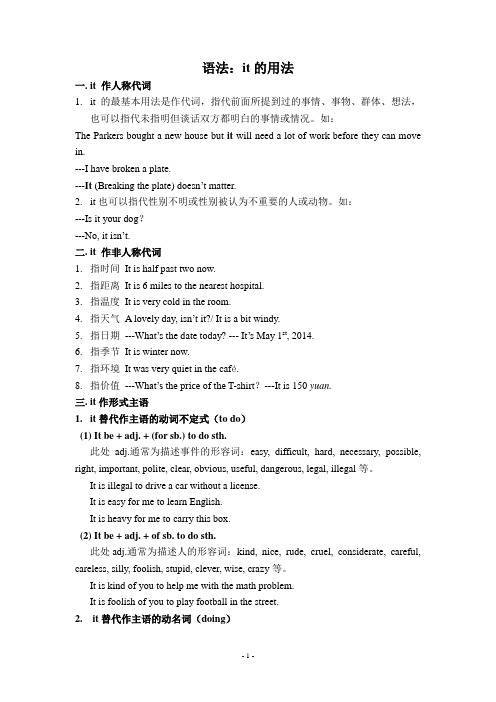
语法:it的用法一.it 作人称代词1.it的最基本用法是作代词,指代前面所提到过的事情、事物、群体、想法,也可以指代未指明但谈话双方都明白的事情或情况。
如:The Parkers bought a new house but it will need a lot of work before they can move in.---I have broken a plate.---It (Breaking the plate) doesn’t matter.2.it也可以指代性别不明或性别被认为不重要的人或动物。
如:---Is it your dog?---No, it isn’t.二.it 作非人称代词1.指时间It is half past two now.2.指距离It is 6 miles to the nearest hospital.3.指温度It is very cold in the room.4.指天气A lovely day, isn’t it?/ It is a bit windy.5.指日期---What’s the date today? --- It’s May 1st, 2014.6.指季节It is winter now.7.指环境It was very quiet in the café.8.指价值---What’s the price of the T-shirt?---It is 150 yuan.三.it作形式主语1.it替代作主语的动词不定式(to do)(1) It be + adj. + (for sb.) to do sth.此处adj.通常为描述事件的形容词:easy, difficult, hard, necessary, possible, right, important, polite, clear, obvious, useful, dangerous, legal, illegal等。
it的用法归纳

it的用法归纳
1. 代词:it可以代替前面出现过的事物、物品、动物等,做主语、
宾语、表语等。
例句:I saw a bird in the tree. It was singing beautifully. (我看见了一只鸟在树上。
它唱得很美。
)。
2. 指示代词:it也可以作为指示代词,用来指代某一事物或物品。
例句:I want this book, not that one. Give me it.(我想要这
本书,不是那本。
给我它。
)。
3. 不定式:it可以作为不定式的形式,表示“它”的含义,一般表
示时间、天气等。
例句:It’s nice to see you again.(很高兴再次见到你。
)。
4. 表示真理或存在:it可以用来表示某件事或事物的存在或真相。
5. 表示强调:it可以作为强调句的主语,强调句子中重要的信息。
例句:It was him who broke the vase, not me.(是他打破了花瓶,不是我。
)。
6. 虚主语:it可以作为虚主语出现在句首,表示无人称、无性别的
动作或状态。
(完整版)It的用法总结

It的用法总结在英语中,it有许多不同的用法,它既可以用作代词(如人称代词、非人称代词),也可以用作引导词(作形式主语或形式宾语),还可以用来构成强调句型。
.it用作代词(1) 用作人称代词在句子中作主语或宾语;指前面已经提到过的事物、动物或人,且it指特定的事物;如果指前文中提到的事物中的任何一个,用one。
one可以与any, each, every, not等连用,但one不可代替不可数名词。
—where’s your car?—it’s in the garage. 你的汽车在哪儿呢?在车库里。
(指代物品your car)did you hit it? 你打中了吗? (指代事件)the baby cried when it was hungry.这婴儿饿时就哭。
(指代婴儿,尤指性别不详或无所谓时)—who is that?—it’s me. 是谁?我。
(指一定情景中所确定的人或事物,此时相当于指示代词,代指this和that,有时也指人)—what’s this?—it’s a box. 这是什么?一只箱子。
(2) 作非人称代词表示天气、日期、时间、温度、距离、价值、路程、度量、自然现象与环境等。
也可模糊地指一般情形或上文的部分或整个意思。
译成汉语时,it通常不一定译出来。
it’s a long time since they left. 他们走后很久了。
it’s two miles to the beach.离海滨有两英里远。
that’s just it—i can’t work when you’re making so much noise.原因就在这里——你弄出这么大的声音,我工作不了。
另外,需要注意两点:(1)“it’s time…”后面可以接不定式和介词短语表示“是做……的时候了”。
如:it’s time for supper. it’s time to have supper.(2) “it’s time…”后面还可以接一个从句,但是从句中的谓语动词一定要用过去式即虚拟语气,如:it’s time we had lunch.是我们吃饭的时候了。
超详细的It的用法归纳总结(附习题及答案)!
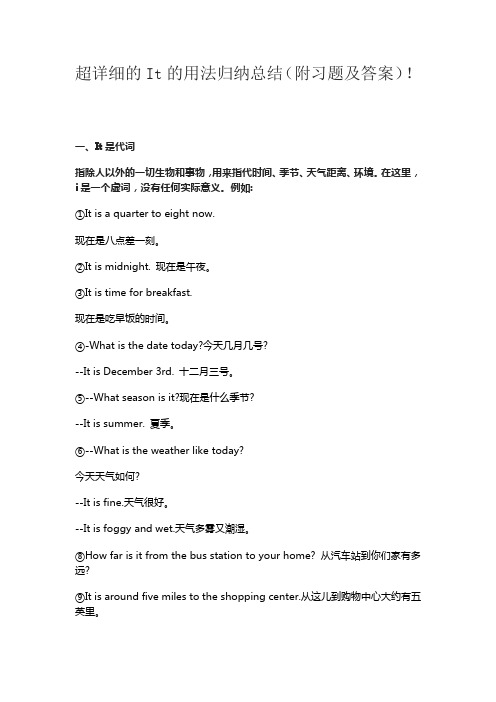
超详细的It的用法归纳总结(附习题及答案)!
一、It是代词
指除人以外的一切生物和事物,用来指代时间、季节、天气距离、环境。
在这里,i是一个虚词,没有任何实际意义。
例如:
①It is a quarter to eight now.
现在是八点差一刻。
②It is midnight. 现在是午夜。
③It is time for breakfast.
现在是吃早饭的时间。
④-What is the date today?今天几月几号?
--It is December 3rd. 十二月三号。
⑤--What season is it?现在是什么季节?
--It is summer. 夏季。
⑥--What is the weather like today?
今天天气如何?
--It is fine.天气很好。
--It is foggy and wet.天气多雾又潮湿。
⑧How far is it from the bus station to your home? 从汽车站到你们家有多远?
⑨It is around five miles to the shopping center.从这儿到购物中心大约有五英里。
it的七种用法
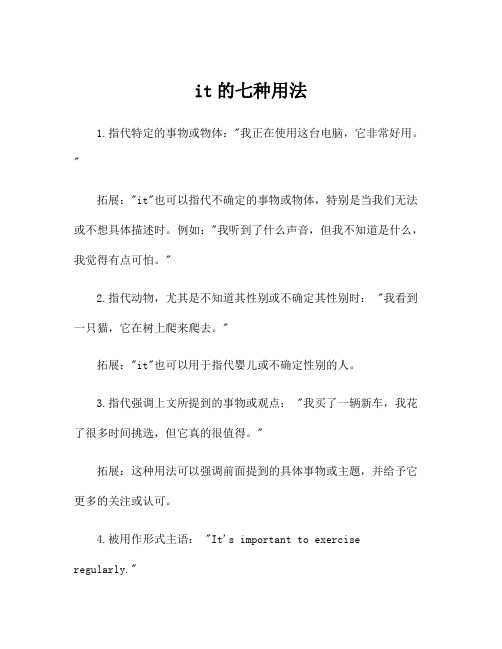
it的七种用法1.指代特定的事物或物体:"我正在使用这台电脑,它非常好用。
"拓展:"it"也可以指代不确定的事物或物体,特别是当我们无法或不想具体描述时。
例如:"我听到了什么声音,但我不知道是什么,我觉得有点可怕。
"2.指代动物,尤其是不知道其性别或不确定其性别时: "我看到一只猫,它在树上爬来爬去。
"拓展:"it"也可以用于指代婴儿或不确定性别的人。
3.指代强调上文所提到的事物或观点: "我买了一辆新车,我花了很多时间挑选,但它真的很值得。
"拓展:这种用法可以强调前面提到的具体事物或主题,并给予它更多的关注或认可。
4.被用作形式主语: "It's important to exercise regularly."拓展:在某些句子中,"it"可以用作形式主语,代表主语部分的内容,尤其是当真正的主语是以后出现时。
5.引导强调句: "It was John who broke the vase."拓展:在强调句中,"it"被用作形式主语,而真正的主语将被放置在句子的后部,以便强调。
6.用于指示时间、天气和环境条件: "It's raining outside."拓展:"it"在描述天气、时间或条件时,常用于英语中,例如:"It's getting late." "It's hot today."7.在某些习语中,表示状态或情感: "I'm over it." (我已经度过了这个困境)拓展:在某些习语或俚语中,"it"用于表示情感、状态或体验,并在一定程度上代表所描述的特定情况。
it的七种用法
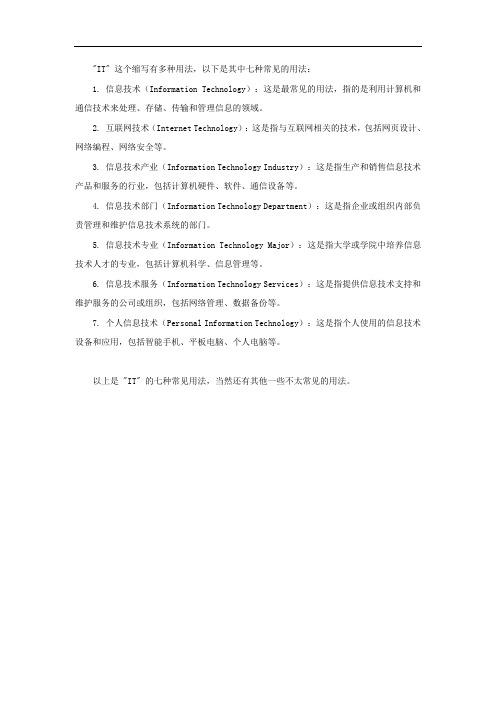
"IT" 这个缩写有多种用法,以下是其中七种常见的用法:
1. 信息技术(Information Technology):这是最常见的用法,指的是利用计算机和通信技术来处理、存储、传输和管理信息的领域。
2. 互联网技术(Internet Technology):这是指与互联网相关的技术,包括网页设计、网络编程、网络安全等。
3. 信息技术产业(Information Technology Industry):这是指生产和销售信息技术产品和服务的行业,包括计算机硬件、软件、通信设备等。
4. 信息技术部门(Information Technology Department):这是指企业或组织内部负责管理和维护信息技术系统的部门。
5. 信息技术专业(Information Technology Major):这是指大学或学院中培养信息技术人才的专业,包括计算机科学、信息管理等。
6. 信息技术服务(Information Technology Services):这是指提供信息技术支持和维护服务的公司或组织,包括网络管理、数据备份等。
7. 个人信息技术(Personal Information Technology):这是指个人使用的信息技术设备和应用,包括智能手机、平板电脑、个人电脑等。
以上是 "IT" 的七种常见用法,当然还有其他一些不太常见的用法。
人称代词it的用法总结
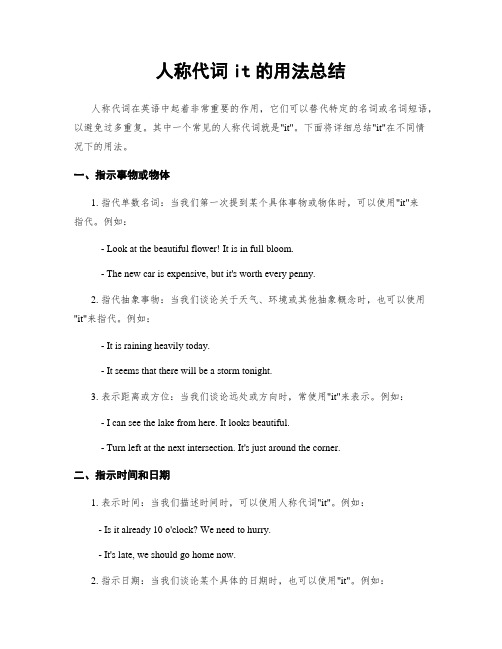
人称代词it的用法总结人称代词在英语中起着非常重要的作用,它们可以替代特定的名词或名词短语,以避免过多重复。
其中一个常见的人称代词就是"it"。
下面将详细总结"it"在不同情况下的用法。
一、指示事物或物体1. 指代单数名词:当我们第一次提到某个具体事物或物体时,可以使用"it"来指代。
例如:- Look at the beautiful flower! It is in full bloom.- The new car is expensive, but it's worth every penny.2. 指代抽象事物:当我们谈论关于天气、环境或其他抽象概念时,也可以使用"it"来指代。
例如:- It is raining heavily today.- It seems that there will be a storm tonight.3. 表示距离或方位:当我们谈论远处或方向时,常使用"it"来表示。
例如:- I can see the lake from here. It looks beautiful.- Turn left at the next intersection. It's just around the corner.二、指示时间和日期1. 表示时间:当我们描述时间时,可以使用人称代词"it"。
例如:- Is it already 10 o'clock? We need to hurry.- It's late, we should go home now.2. 指示日期:当我们谈论某个具体的日期时,也可以使用"it"。
例如:- I have an important meeting on Friday. It's going to be a long day.- The party is on Saturday night. It starts at 8 o'clock, so don't be late.三、指代动物和婴儿1. 指代动物:当我们不知道或不关心动物的性别时,可以使用"it"来指代动物。
IT的用法

IT的用法1.做人称代词:指事物,动物,抽象概念,有时可指小孩(在不强调性别的情况下)如:He read a play of mine ,but he didn’t much like it.他读了我的一个剧本,但不怎么喜欢。
Your wife won’t like it 你的妻子不会喜欢它(it指事物)2.作指示代词表示一个人或事物Who is it? It is me.It is only the wind shaking the house.只不过是风在摇晃房屋It must be the kids coming home. 肯定是孩子们回来了3.用做非人称代词,表示时间、日期、天气、距离,环境等。
It is a long way to the station.Now it is cleaning up. 现在天在变晴It is about seven o’clock.4.用做先行代词,做形式主语,真正的主语通常放在后面。
1)it可以代表动词不定式或动词不定式短语(可以是动词不定式的一般形式,进行式,完成式,也可以是动词不定式复合结构)(1)it +be+adj+to+vit wasn’t easy to win the match.it is wrong to tell her the truth.it is better to give than to receive.it is really nice of you to come to see me off. 你来给我送行真好it’s necessary for you to make the decision right now.(2) it +be +n+to+vIt’s my duty to help the people in trouble.It was not his habit to ask people for things. 他不习惯向人们索取东西Oh what a shame (it is) to treat you like that. 如此对待你太不象话(3)it+vt+n/pron+to-vIt’ll take only ten minutes to walk there.It makes me sick to think about it.想到那件事我就想呕吐。
it的用法
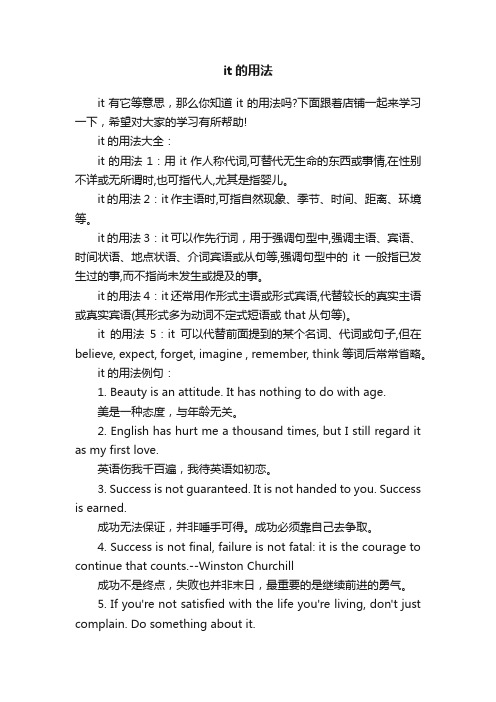
it的用法it有它等意思,那么你知道it的用法吗?下面跟着店铺一起来学习一下,希望对大家的学习有所帮助!it的用法大全:it的用法1:用it作人称代词,可替代无生命的东西或事情,在性别不详或无所谓时,也可指代人,尤其是指婴儿。
it的用法2:it作主语时,可指自然现象、季节、时间、距离、环境等。
it的用法3:it可以作先行词,用于强调句型中,强调主语、宾语、时间状语、地点状语、介词宾语或从句等,强调句型中的it一般指已发生过的事,而不指尚未发生或提及的事。
it的用法4:it还常用作形式主语或形式宾语,代替较长的真实主语或真实宾语(其形式多为动词不定式短语或that从句等)。
it的用法5:it可以代替前面提到的某个名词、代词或句子,但在believe, expect, forget, imagine , remember, think等词后常常省略。
it的用法例句:1. Beauty is an attitude. It has nothing to do with age.美是一种态度,与年龄无关。
2. English has hurt me a thousand times, but I still regard it as my first love.英语伤我千百遍,我待英语如初恋。
3. Success is not guaranteed. It is not handed to you. Success is earned.成功无法保证,并非唾手可得。
成功必须靠自己去争取。
4. Success is not final, failure is not fatal: it is the courage to continue that counts.--Winston Churchill成功不是终点,失败也并非末日,最重要的是继续前进的勇气。
5. If you're not satisfied with the life you're living, don't just complain. Do something about it.对于现况的不满,不能只是抱怨,要有勇气作出改变。
It 的用法

It 的用法1. it 常用作形式主语代替真正的主语不定式、动名词或从句。
It +be+ adj./ n. + (for / of sb) +to do sthIt + be +no use/ good/ useless + doingIt + be + adj./ n. / p. p. +wh- clause/ that- clauseeg: ①It is important for us to master a second language.②It is considerate of you to turn down the radio when the baby is asleep.③It is no use crying over spilt milk.④ It is a fact that English is being accepted as an international language.⑤It needs further discussion whether we’ll build a lab-oratory or not.⑥It is reported that 14 people were killed in the crash.2. it 作形式宾语,代替后面的真正宾语不定式、动名词或从句。
※find/ think/ feel/ make/ consider +it +adj. /n. +to do sth.eg: ①I think it necessary to discuss with him about this.②I owe it to you that I have survived the disaster.③We shall leave it to him to settle the matter.④He saw to it that the work was finished on time.3. It +takes +sth +to do sth “做某事需要……”eg: ①It takes much patience to do the work.②It took us two hours to get there on foot.4. It +be +(high) time +(that)……“(早)是该做某事的时候了”5. It +be +the first (second…)time +(that)…“是某人第一(二,…)次做某事。
It 的用法
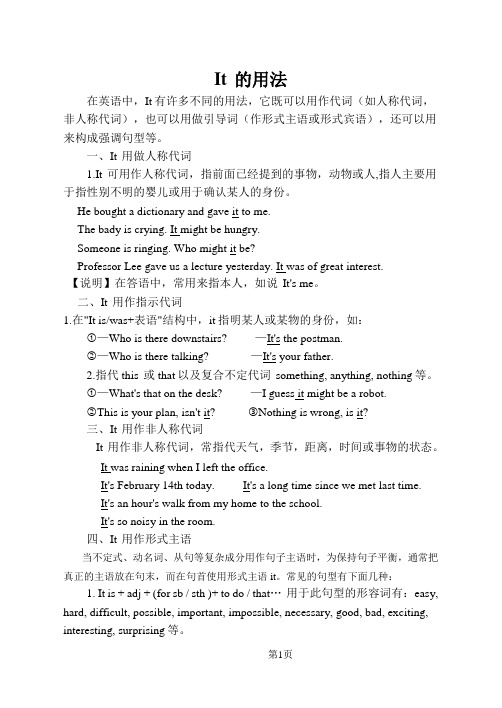
It 的用法在英语中,It有许多不同的用法,它既可以用作代词(如人称代词,非人称代词),也可以用做引导词(作形式主语或形式宾语),还可以用来构成强调句型等。
一、It 用做人称代词1.It 可用作人称代词,指前面已经提到的事物,动物或人,指人主要用于指性别不明的婴儿或用于确认某人的身份。
He bought a dictionary and gave it to me.The bady is crying. It might be hungry.Someone is ringing. Who might it be?Professor Lee gave us a lecture yesterday. It was of great interest.【说明】在答语中,常用来指本人,如说It's me。
二、It 用作指示代词1.在"It is/was+表语"结构中,it指明某人或某物的身份,如:①—Who is there downstairs? —It's the postman.②—Who is there talking? —It's your father.2.指代this 或that以及复合不定代词something, anything, nothing等。
①—What's that on the desk? —I guess it might be a robot.②This is your plan, isn't it? ③Nothing is wrong, is it?三、It 用作非人称代词It 用作非人称代词,常指代天气,季节,距离,时间或事物的状态。
It was raining when I left the office.It's February 14th today. It's a long time since we met last time.It's an hour's walk from my home to the school.It's so noisy in the room.四、It 用作形式主语当不定式、动名词、从句等复杂成分用作句子主语时,为保持句子平衡,通常把真正的主语放在句末,而在句首使用形式主语it。
It的用法总结

⼀、⼈称代词1,it的最基本⽤法是作代词,主要指刚提到的事物,以避免重复:①They watched the train until it disappeared in the distance.2.,也可以指动物或婴⼉(未知性别的婴⼉或孩⼦):②Is this your dog?No, it isn’t.③They got a baby and it was a ten-pounder3.,也可指抽象事物或指抽象环境和情景:③I hate it when people talk with a full mouth..⼆、.⾮⼈称代词1.it有时并不指具体的东西⽽泛指天⽓、时间、⽇期、距离、价值、度量、温度、环境等:⑴.指天⽓:It is a lovely day, isn’t it?⑵.指时间: It was nearly midnight when she came back.⑶.指⽇期:It is April First today.⑷.指距离:It is some 3000 kilometers from Beijing to Guangzhou.⑸.指价值:It is three dollars.⑹.指温度:Today it is 30 degrees centigrade.三、其他⽤法1.在句⼦的主语不太明确时充当主语,表⽰谁在做某事:①Who is it there? It's I (me/you/he.....).②I thought it was Mary, but it was not she.③Her face lighted when she saw who it was.2.泛泛的指某件事: (有时泛指⼀般情况)①It doesn’t matter.②It is a shame, isn’t it?③How is it going?(情况怎样)④It says in the newspaper that......3.it⽤在⼀些词组中,it 没有特别的意思The last train's gone. Come on, we'll foot it.(来,咱们步⾏吧。
it在英语中的用法
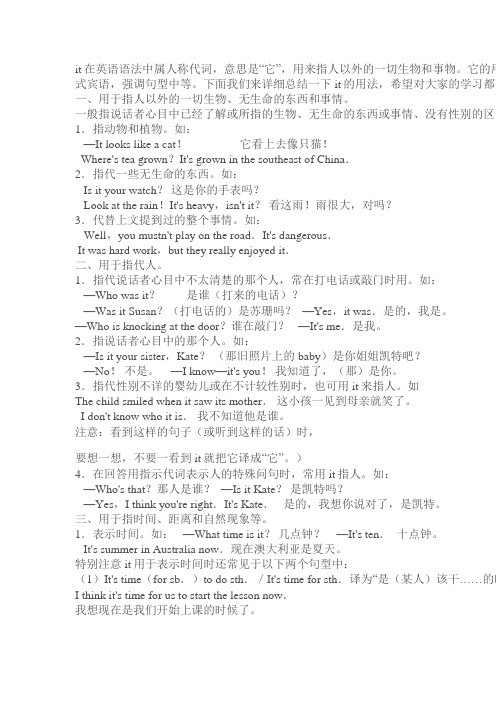
it在英语语法中属人称代词,意思是“它”,用来指人以外的一切生物和事物。
它的用形式宾语,强调句型中等。
下面我们来详细总结一下it的用法,希望对大家的学习都一、用于指人以外的一切生物、无生命的东西和事情。
一般指说话者心目中已经了解或所指的生物、无生命的东西或事情、没有性别的区分1.指动物和植物。
如:—It looks like a cat!它看上去像只猫!Where's tea grown?It's grown in the southeast of China.2.指代一些无生命的东西。
如:Is it your watch?这是你的手表吗?Look at the rain!It's heavy,isn't it?看这雨!雨很大,对吗?3.代替上文提到过的整个事情。
如:Well,you mustn't play on the road.It's dangerous.It was hard work,but they really enjoyed it.二、用于指代人。
1.指代说话者心目中不太清楚的那个人,常在打电话或敲门时用。
如:—Who was it?是谁(打来的电话)?—Was it Susan?(打电话的)是苏珊吗?—Yes,it was.是的,我是。
—Who is knocking at the door?谁在敲门?—It's me.是我。
2.指说话者心目中的那个人。
如:—Is it your sister,Kate?(那旧照片上的 baby)是你姐姐凯特吧?—No!不是。
—I know—it's you!我知道了,(那)是你。
3.指代性别不详的婴幼儿或在不计较性别时,也可用it来指人。
如The child smiled when it saw its mother.这小孩一见到母亲就笑了。
I don't know who it is.我不知道他是谁。
it的用法、常用句型

I’d prefer it if I didn’t have to do so much
work.
I would appreciate it very much if you would
help me with it.
b. 动词+介词+ it + that从句 能用于此句型的主要有:depend on, answer for, see to。如: You may depend on it that he will turn up in time.
reputation of an honest man.
It was no accident that such a book should
appear in the 18th century. 2) “It + be +形容词+主语从句”中从句谓语常用 “(should +)动词原形(或完成时)”。常用 于本句型的形容词主要有impossible, strange,
2. —Steven’s parents have bought him a computer.
—__I_t _ __is__ __n_o_ _w__o_n_d_e_r_ (难怪) that he looks so happy.
3. Susana’s aim is to tell all citizens they have a duty to protect the environment, _is_n_’_t_ __it_ (对吗)?
2. Raise your leg and let 65 stay in the air for seconds. (辽宁2014第三部分)
It的用法(超全)
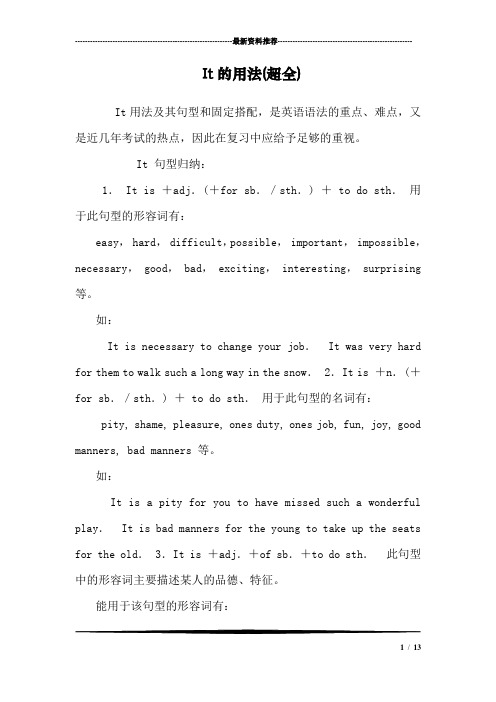
---------------------------------------------------------------最新资料推荐------------------------------------------------------It的用法(超全)用法及其句型和固定搭配,是英语语法的重点、难点,又是近几年考试的热点,因此在复习中应给予足够的重视。
句型归纳:1. It is +adj.(+for sb./sth.) + to do sth.用于此句型的形容词有:easy, hard, difficult,possible, important, impossible,necessary, good, bad, exciting, interesting, surprising 等。
如:It is necessary to change your job. It was very hard for them to walk such a long way in the snow. 2.It is +n.(+for sb./sth.) + to do sth.用于此句型的名词有:pity, shame, pleasure, ones duty, ones job, fun, joy, good manners, bad manners 等。
如:It is a pity for you to have missed such a wonderful play. It is bad manners for the young to take up the seats for the old. 3.It is +adj.+of sb.+to do sth.此句型中的形容词主要描述某人的品德、特征。
能用于该句型的形容词有:1 / 13kind, nice, wise, silly, polite, impolite, friendly, foolish, clever 等。
英语中it的用法

it 在英语中的意思较多,用法较广,现总结如下;一、it作句子的真正主语1.it 指前面已经提到过的人或事物,有时指心目中的或成为问题的人或事物,作真正主语;例如:What’s this -It is a sheep这是什么这是一只绵羊;Who is it -It’s me I. 谁是我;It’s the wind shaking the window. 是风刮得窗户响;2.it指时间、季节;一般用在无人称动词的主语;例如:What time is it -It’s nine. 几点了九点了;It’s time for the meeting. Let’s go. 开会的时间到了,我们走吧;What day is today -It’s Saturday. 今天星期几今天星期六;What’s the date today -It is October 1st.今天是几号今天是十月一日;What season is it -It is summer. 现在是什么季节是夏季;3.it 指气候;一般作无人称动词的主语;例如:Is it cold in this room -No, it isn’t. 屋里冷吗不冷;What’s the weather like today -It is fine.今天天气怎么样是晴天;It often rains in summer and it often snows in winter in this city.这个城市夏天经常下雨,冬天经常下雪;4.it指距离、情况等;一般用作无人称动词的主语;例如:It is five kilometers from my home to the school.从我家到学校有五公里;It is very near from this factory to that one.从这个工厂到那个工厂非常近;It is a long way to the sea. 离海很远;Is it well with you 你身体好吗二、it作形式主语动词不定式、动名词短语起、从句在句子中起主语作用,而这一部分用词较多时,可以用it作为形式主语,放在句首代表其后所说的事实上的、真正的主语,而把真正的主语放在后面;1.It +谓语+动词不定式;It 作形式主语,动词不定式作真正的主语;例如:It is difficult to climb a mountain. 爬山是很艰难的;It’s a good habit to do morning exercises. 作早操是个好习惯;It’s important to do proper memory work in the study of a foreign language. 在学习外语时适当地做一些有助于记忆的练习是很重要的;It is right to do so. 这样做是对的;2.It+谓语+动名词短语;It 作形式主语,动名词短语作真正的主语;例如:It is dangerous playing with fire. 玩火是危险的;It is no use learning without thinking. 学而不思则罔;It’s useless arguing with a silly boy. 和笨孩子争论是没有用的;3.It +谓语+名词性从句;It 作形式主语,以that 引导的名词性从句是真正的主语;例如:It is a pity that you didn’t see such a good film.你没看这么好的电影,真可惜;It is certain that we shall succeed. 我们一定会成功;It is strange that nobody knows where he lives.真奇怪,谁也不知道他住在哪里;It is strange that…后面可用虚拟语气;如:It is strange that he should have made such a mistake.他居然犯了这样一个错误,真奇怪;It is strange that nobody should know where he lives.居然没有人知道他住在哪里,真奇怪;It is said that the plane will take off at ten tomorrow morning.据说飞机明天上午十点起飞;三、it作形式宾语it 作形式宾语,代表其后所说的真正的宾语;真正的宾语是以that 引导的名词性从句或不定式短语;例如:I consider it wrong that you Chinese students learn English without comparing it with your own language.我认为你们中国学生学习英语,不和你们自己的语言比较是不对的;I find it not so difficult to learn a foreign language.我发现学习一门外语不那么困难;I remember I made it clear to you that I was not coming.我记得向你明确表示过我不来;They want to make it clear to the public that they are doing an important and necessary job.他们要向公众表明,他们在做一件重要而又必要的工作;四、it 用于强调结构在表示强调的结构中,it 可用作先行代词,这种结构的句型如下:It +is/was +被强调的部分+that +其他部分;如果强调的部分是人,可用who, whom 代替that.例如:Professor Wang teaches us English every Monday afternoon.王教授每星期一下午教我们英语;强调主语:It is Professor Wang who teaches us English every Monday afternoon.强调间接宾语:It is us whom Prof. Wang teaches English every Monday afternoon. 强调直接宾语:It is English that Prof. Wang teaches us every Monday afternoon.强调状语:It is every Monday afternoon that Prof. Wang teaches us English.It was here that I first met him. 这就是我初次与他见面的地方;强调状语It is the people who are realy powerful.翻译练习1该上课了,快;It is time for class. Hurry up.2从这儿到你们学校远吗不远,大约一公里;Is it far from here to your school No, it isn’t. It’s about a kilometer.3从我家到颐和园去很近;It is very near from my home to the Summer Palace.4天正在下雨;It’s raining now.5电灯是爱迪生发明的;It was Edison who invented the electric light.6我认为学习一门外语是很重要的;I think it important to learn a foreign language.7他通常一天读两次英语;He made it a rule to read English twice a day.8从我家去天安门广场坐公共汽车大约要一个小时;It takes about an hour to go from my home to the Tian’anmen Square by bus.反意疑问句反意疑问句相当于“对不对”“好不好”“行不行”,用yes或 no 回答;由两部分组成,前一部分是陈述句,后一部分是附加疑问短语,中间用逗号隔开,所以反意疑问句又叫附加疑问句;通常的形式是:肯定的陈述句+否定的附加疑问,或否定的陈述句+肯定的附加疑问;如:He studies English, doesn’t heHe doesn’t study English, does heThey are from America, aren’t theyThey are not from America, are they反意疑问句的主要形式:1.如果主句是be或其他助动词如can, shall, will 等,其反意疑问句用同一助动词; 如:We are late, aren’t weYou haven’t met my wife, have youHe can drive a car, can’t heThey used to have difficulty in just making ends meet, didn’t usedn’t theyYou’d better eat with knives and forks, hadn’t you2.如果主语带有seldom, hardly, never, rarely, few, little等否定词或半否定词时,因为主句本身具有否定意义,附加疑问部分的动词用肯定式,如:We seldom go to the cinema, do weSue almost never worked, did she3.如果主句部分是“I am…”结构,由于”am not” 没有相应的缩略形式,附加疑问部分一般用aren’t I 代替;如:I am your friend, aren’t II’m late, aren’t II am a student, aren’t I在祈使句中的附加疑问部分一般用will you, won’t you.4. 在祈使句中的附加疑问部分一般用will you, won’t you.如:Sit down, will youHave some tea, won’t youOpen the window, won’t you这种句子可以理解为: Will you do something如:Will you open the window注意:否定的祈使句之后,只能用will.Don’t forget, will youDon’t make so much noise, will you5.以Let’s… 开头的祈使句,肯定的用shall we否定的用all right或OK,如:Let’s go back to our seats, shall weLet’s not have hot food this t ime, OK all right这种句子可以理解为:Shall we do something,如:Shall we go back to our seats.这样有助于理解和记忆;注意:Let’s 与Let us 的区别:Let’s包括听话人在内,应用shall we, 而Let us 不包括听话人在内,表示“请你让我们…”,要用will you.如:Let’s watch the news on TV, shall we 表示建议Let us watch the news on TV, will you 表示请求6.主句是I suppose, I think, I believe等时,附加疑问部分则往往与that 从句中的主语和谓语动词保持对应关系,但要注意否定的转移;如:I suppose that you know the meaning of the word, don’t you这句话明显是要问“你是不是知道”而不是问“我是不是这样认为”I don’t think that you have read the book, have you7.当主句的动词have 表示“拥有”时,附加疑问既可用have, 也可用do,如:You have a color TV set, haven’t you/don’t you当主句的have不表示“拥有”而表示其他意思时,附加疑问要用do,如:You had a cold yesterday, didn’t youThey don’t have coffee with breakfast, do theybe句型的反意疑问句,用there 作主语;如:There is something wrong, isn’t thereThere won’t be any trouble, will there 不会有任何麻烦,是吗9.陈述部分的主语是everyone, someone, anyone, no one, nobody等不定代词时,其疑问部分的主语可用he, 也可用they.Everyone knows it, doesn’t he/don’t they英语反意疑问句的回答有点和汉语的相反;但一定要记住:只要回答是肯定的,都用yes,只要回答是否定的,都用no;这在主句是否定句的时候要特别注意;例如:Mr. Jones can’t speak French, can he No, he can’t.琼斯先生不会讲法语,对吗对,他不会讲法语;Mr. Jones can’t speak French, can he Yes, he can.琼斯先生不会讲法语,对吗不,他会讲法语;This is not a door, is it -Yes, it is. It is an iron door.这不是门,对吗不,这是门;是扇铁门;。
It的用法
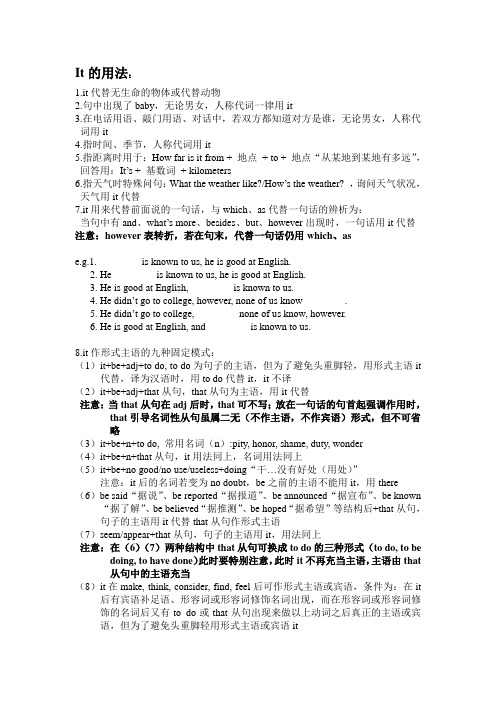
It的用法:1.it代替无生命的物体或代替动物2.句中出现了baby,无论男女,人称代词一律用it3.在电话用语、敲门用语、对话中,若双方都知道对方是谁,无论男女,人称代词用it4.指时间、季节,人称代词用it5.指距离时用于:How far is it from + 地点+ to + 地点“从某地到某地有多远”,回答用:It’s + 基数词+ kilometers6.指天气时特殊问句:What the weather like?/How’s the weather? ,询问天气状况,天气用it代替7.it用来代替前面说的一句话,与which、as代替一句话的辨析为:当句中有and、what’s more、besides、but、however出现时,一句话用it代替注意:however表转折,若在句末,代替一句话仍用which、ase.g.1. ________ is known to us, he is good at English.2. He ________ is known to us, he is good at English.3. He is good at English, ________ is known to us.4. He didn’t go to college, however, none of us know ________.5. He didn’t go to college, ________ none of us know, however.6. He is good at English, and ________ is known to us.8.it作形式主语的九种固定模式:(1)it+be+adj+to do, to do为句子的主语,但为了避免头重脚轻,用形式主语it 代替,译为汉语时,用to do代替it,it不译(2)it+be+adj+that从句,that从句为主语,用it代替注意:当that从句在adj后时,that可不写;放在一句话的句首起强调作用时,that引导名词性从句虽属二无(不作主语,不作宾语)形式,但不可省略(3)it+be+n+to do, 常用名词(n):pity, honor, shame, duty, wonder(4)it+be+n+that从句,it用法同上,名词用法同上(5)it+be+no good/no use/useless+doing“干…没有好处(用处)”注意:it后的名词若变为no doubt,be之前的主语不能用it,用there (6)be said“据说”、be reported“据报道”、be announced“据宣布”、be known “据了解”、be believed“据推测”、be hoped“据希望”等结构后+that从句,句子的主语用it代替that从句作形式主语(7)seem/appear+that从句,句子的主语用it,用法同上注意:在(6)(7)两种结构中that从句可换成to do的三种形式(to do, to be doing, to have done)此时要特别注意,此时it不再充当主语,主语由that从句中的主语充当(8)it在make, think, consider, find, feel后可作形式主语或宾语,条件为:在it 后有宾语补足语、形容词或形容词修饰名词出现,而在形容词或形容词修饰的名词后又有to do或that从句出现来做以上动词之后真正的主语或宾语,但为了避免头重脚轻用形式主语或宾语it(9)用于it takes sb some time/some money to do sth中代替to do 作主语,表“花费某人多少时间/金钱干某事”,此句型中的sb可省,take译为“需要”,相当于needE.g.1._______ is important for us to learn English well.2._______ is clear that he is the best in his class.3._______ is no good _______ (take) in your parents.4._______ is no doubt that he has gone to college.5. We all found _______ important to go to college.6._______ took us hours to do our homework.7._______ takes hardworking to go to college.9.it代替时间的六种固定模式:(1)it is time for sth=it is time to do sth“该到干…的时间了”(2)it’s time for sb for sth=it’s time for sb to do sth“该到某人干某事的时间了”(3)it’s time +that从句=it’s about time +that从句“该到干某事的时间了”注意:that从句用虚拟语气如同would rather+that从句用虚拟,它们的虚拟为时间段的虚拟—对现在/将来:一般过去时;对过去:过去完成时,此时的that从句一定用过去时(4)It is/was/will be +the+序数词+time+that从句“干…是第几次了”注意:A. it 可用this/that/yesterday代替B.序数词之后的time可用day/month/year代替C.that从句要根据主从句一致的原则使用现在完成时或过去完成时,也就是说,遇到be之后出现序数词+单数名词,它的从句:用that引导,且为完成时态(5)it+be+years/days/months+since+从句“自从…是多少年/天/月了”注意:A.主从句时态不一致B.be用is/has been代替,表现在完成时C.since后的从句要用一般过去时,体现since+过去时的句子为现在完成时的标志D.be有时也可用was代替,要注意时态的一致性,即since得从句由一般过去时变为过去完成时(6)it用于强调句型,强调除谓语动词之外的一切成分:It is/was +强调部分+that/who+原句其他成分,但一定要照抄不变,使用时注意:A. is/was体现主从句时态一致原则.B.强调部分若为人,既可用that也可用who,反之用thatC.当强调部分为名词,后又设两空,此时第一空根据定语从句的引导词判断,第二空根据强调句型的引导词判断D.强调句型变特殊疑问句,它的特殊疑问词就是所强调部分,结构:特殊疑问词+is/was it that+句中其他成分E.强调句若强调“直到…才”即not…until…句型时,此时一定要将主句中的not,从句中的until并列使用,构成强调句型,此用法类似于not…until…句型放于句首引起半倒装结构时,not…until…也要并列F.强调句型与it is/was +无介词的段时间和点时间的辨析(引导词):此时无介词的段时间引导词用before,表“…之后”,无介词的点时间用when,表“…时候”,反之有介词,引导词一律用that构成强调句注意:上述中点时间不一定指具体时间,可以为具体的一年/月/天G.强调句与其他句型不同的标志是:去掉it is/was以及that/who,句子仍成立E.g.1._______ is time that we _______ to work.A. It, goB. It, wentC. That, goD. That, went2._______ is the third time that she _______ you.A. It, ringsB. It, has rungC. It, had rungD. That, had rung3. It _______ five years since I _______ English.A. is, has studiedB. has been, studiedC. is, studiedD. was, studied4. It was five years since I _________ (study) English.5. It was the man _______ we talk about _______ went abroad.6. It was five years _______ we met each other.7. It was for five years _______ we have met each other.8. It was 1980 _______ I was born.9. It was in 1980 _______ I was born.。
- 1、下载文档前请自行甄别文档内容的完整性,平台不提供额外的编辑、内容补充、找答案等附加服务。
- 2、"仅部分预览"的文档,不可在线预览部分如存在完整性等问题,可反馈申请退款(可完整预览的文档不适用该条件!)。
- 3、如文档侵犯您的权益,请联系客服反馈,我们会尽快为您处理(人工客服工作时间:9:00-18:30)。
•Never be afraid of grammar•Collect some examples;•Watch them very carefully;•Find out something in common;•Try to use the rules ---- practise.it用法完全归纳一、it 作人称代词的用法1.指事物作为人称代词,it 可以除人以外的一切事物或动物。
如:I dropped my watch and it broke. 我把手表掉在地上摔坏了。
It’s hard work, but I enjoy it. 工作很辛苦,可是我乐意干。
“Where is the dog?”“It’s in the bedroom. ”“狗在哪?”“在卧室里”。
2.指人it 指人主要用于指不性别不明的婴儿或用于确认某人的身份。
如:Is it a boy or a girl? 是男孩还是女孩?There is a knock on the door. It must be the postman. 有人在敲门,一定是邮递员。
【说明】在答语中,常用来指本人,如说It’s me。
3.代替某些代词代词it 还可用于代替指示代词this, that 以及复合不定代词something, anything, nothing等。
如:“What’s this?”“It’s a new machine. ”“这是什么?”“是一种新机器”。
Nothing is wrong, is it? 没出什么问题,是吗?二、it 作非人称代词的用法1.基本用法it 作非人称代词的用法,主要用于指时间、距离、价值、天气、气候及温度等自然现象。
如:It’s too late to go there now. 现在去那儿已经太迟了。
It rained all day yesterday. 昨天下了一天的雨。
It can get very hot here. 这里有时会很热。
2.用于某些句型It’s time for sth. 该做某事了。
It’s time to do sth. 该做某事的时候了。
It’s time for sb to do sth. 某人该干某事了。
It’s (about / high) time + that-从句. 某人该做某事了。
(从句谓语用过去式,有时也用“should+动词原形”)It’s first (second) time + that-从句. 某人第几次干某事。
(从句谓语用现在完成时)It’s + 时间段+ since-从句. 自从……有一段时间了。
It’s + 时间段+ before-从句. 过多长的时间才……三、it用作形式主语1.基本用法当不定式、动名词、从句等复杂成分用作句子主语时,为保持句子平衡,通常把真正的主语放在句末,而在句首使用形式主语it。
如:It’s very important to remember this. 记住这一点很重要。
It’s hard work climbing mountains. 爬山是费劲的事。
It’s unknown when he will come. 他什么时候来还不知道。
2.用作形式主语的的重要句型(1) It + be + adj. for (of) sb to do sth 某人做某事……It is hard for him to make up his mind. 他很难下定决心。
It was foolish of her to say such a thing. 她说那样的话,真是太蠢了。
【说明】介词of 与for 的区别是:of 用于指某人的性格、属性、特征等,介词for表示对象,意为“对……来说” (from )。
(2) It takes sb + 时间段+ to do sth. 某人做某事花了……时间It takes years to master a new language. 要花多年的时间才能掌握一门新的语言。
【说明】此句型可以有以下多变种变体:It took me an hour to write the letter. =The letter took me an hour (to write). =I took an hour to write the letter. 我写这封信花了一个小时。
(3) It is up to sb to do sth. 该由某人做某事It’s up to you to to make the choice. 得由你来作选择。
(4) it look (seem, appear, happen, occur) that [as if]…似乎……It seemed as though he didn’t recognize me. 他似乎没认出我来。
It happened that I was out when he called. 他打电话时我碰巧不在家。
(5) If it were not for… / If it hadn’t been for…若不是因为……If it were not for their help, we couldn’t have got over the difficulties. 要不是他们帮助,这些困难我们不克服不了的。
四、it用作形式宾语1.基本用法当不定式、动名词、从句等复杂成分用作宾语且其后跟有宾语补足语时,通常会在宾语补足语前使用形式宾语,而将真正的宾语移至句末。
其基本结构为“动词+it+宾语补足语+不定式(动名词或从句)”。
如:I find it difficult to do the job well. 我发现做好这件事不容易。
I think it best that you should stay here. 我认为你最好住这儿。
We think it no use complaining. 我们认为抱怨是没有用的。
2. 用作形式宾语的几个特殊结构(1)动词+ it + that-从句。
如:I like it that you came. 你来了,我很高兴。
I take it (that) he will come on time. 我认为他会准时来的。
You can put it that it was arranged before. 你可以说这是以前安排的。
Rumor has it that the defence minister will soon resign. 据传闻,国防部长不久就要辞职。
【说明】能用于此结构的动词不多,常见的有have, take, put, like 等。
(2)动词+ it + when (if)-从句。
如:I dislike it when you whistle. 我不爱听你吹口哨。
(from )We really appreciate it when she offered to help. 她来帮忙了,我们十分感激。
I’d prefer it if I didn’t have to do so much work. 要是我不必做那么多工作,好就太好了。
【说明】能用于此结构的动词不多,常见的有enjoy, hate, love, like, dislike, appreciate, prefer 等。
(3)动词+ prep + it + that-从句。
如:See to it that you’re not late again. 注意千万不要再迟到。
Look to it that this doesn’t happen again. 注意不要再发生这种事。
You may rely on it that he’ll come to meet you. 你放心,他会来接你的。
I can’t answer for it that he will come. 我不能保证他会来。
(from )【说明】能用于此结构的动词不多,常见的有see to, look to, insist on, stick to, depend on, answer for 等。
(4)动词+ it + 介词短语+ that-从句。
如:I owe it to you that I am still alive. 多亏有你我才仍然活着。
I took it for granted that he would help us. 我认为他会帮助我们的。
【说明】能用于此结构的动词不多,常见的有take it for granted, bring it to sb’s attention, owe it to sb 等。
It 的用法练习一.单项选择。
1.Was it during the Second World War _____he died?A.thatB.whileC.in whichD.then2.Is ____ necessary to take off our shoes when we enter the lab?A. everyoneB.thisC.herD.it3. Is ____ possible to fly to the moon in a spaceship?A.nowB.thatC.itD.man4. I don’t think ___ possible to master a foreign language without much memory work.A.thisB.thatC.itsD.it5.She heard of a terrible noise, ___ brought her heart into her mouth.A.itB.whichC.thisD.that6.Alice received an invitation from her boss, ____ came as a surprise.A.itB.thatC.whichD.he7.Does ____ matter if he can’t finish the job on time?A.thisB.thatC.heD.it8.Tom’s mother kept telling him that he should work harder, but ____ didn’t help.A.heB.whichC.sheD.it9.The weather turned out to be very good, ___ was more than we could expect.A.whatB.whichC.thatD.it10.____is a fact that English is being accepted as an international language.A.ThereB.ThisC.ThatD.It11.I hope there are enough glasses for each guest to have _____.A.itB.thoseC.themD.one12.It was about 600 years ago___the first clock with a face and an hour hand was made.A.thatB.untilC.beforeD.when13.I hate ____ when people talk with their mouths full.A.itB.thatC.theseD.them14.It was only when I reread his poems recently____ I began to appreciate their beauty.A.untilB.thatC.thenD.so15.It is the ability to do the job ____ matters not where you come from or what you are.A.oneB.thatC.whatD.it16.It ____ you that ____ to blame.A.is;isB.is; areC.are;areD.are;is17.Was_____that I saw last night at the concert?A.it youB.not youC.youD.that you18.____ electricity plays such an important part in our life?A.Why is it thatB.Why is itC.Why it is thatD.Why is that19.It was ____ he said _____ disappointed me.A.what;whatB.that;thatC.what;thatD.that;what20.It was in the lab ___ was taken charge of by Professor Harris ___ they did the experiment.A.which; thatB.that; whatC.whom; thatD.which; where二.分析it成分,辨清相似句型。
